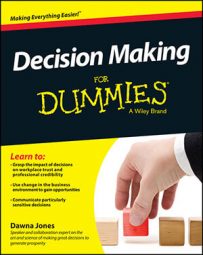Beliefs can limit or expand thinking. As Henry Ford said, “Whether you think you can or can’t, you’re right.” In other words, your beliefs can limit your view of what is and is not possible.
Check out limiting beliefs
The table lists examples of limiting beliefs. In the left column are personal limiting beliefs; in the right, are the usual business limiting beliefs.
| Personal Limiting Belief | Business Limiting Belief |
|---|---|
| “I have to choose between making a living and making a difference. I can’t have both.” | “It’s a battle. We have to fight to survive.” |
| “I can’t make money and do what I love to do. If I follow my passion, I have to sacrifice my lifestyle.” | “If our product and service are brilliant, the customer will come.” |
| “I have to take this job because another one might not come up.” | “If you aren’t in business solely to make a profit, you’re anti-capitalist.” |
| “Personal growth is a bunch of hooey. You have to be tough and force your way to success.” | “How can we possibly learn anything about management from those people?” |
| “There is no need to change what I’m doing as long as everything is under control.” | “Self-organizing doesn’t work for us. We’re different.” |
It’s easy to miss how your thinking influences your decision-making. Beliefs aren’t good or bad. They serve either to limit or empower. Sorting out what role your beliefs play in your life, your work, and your decisions gives you the power to decide which beliefs you keep and which you change.
Weed out your own limiting beliefs
Innovation and radical breakthroughs are impossible without freeing up thinking. Inventors constantly meet up with limiting beliefs in reaction to their ideas. Being able to spot potential in offbeat ideas or unusual opportunities requires constant questioning to expose limiting beliefs. To understand how beliefs affect your thinking and your business, follow these steps:
Make a list of what you believe to be true about your business.
These are your surface beliefs. They may sound like, “I don’t believe that investing in leadership is important” or “We need to concentrate on what is practical and forget the rest.” This list gives you an idea of what you use as a basis for your decisions or to rationalize them. If you can’t name any, head to Step 2.
None of the statements you write is bad or good, true or false. Identifying what is being said simply makes the thinking visible. So don’t censor your list.
Listen to your self-talk about what you can or can’t do or what you do or don’t believe to be true.
Self-talk refers to the hidden beliefs, like “I’m not good enough” or “self-managing doesn’t work,” that sit below your awareness. It includes thoughts running through your mind, as well as phrases that pop out uncensored in response to a situation.
To identify your own self-talk, observe the language you use when you talk about yourself and your abilities, either inside your head or when you’re talking to friends. As you uncover your own self-talk, add each item to your list. If you’re having difficulty, ask someone you trust to help alert you to self-deprecating comments that repress your self-value and initiative.
The purpose of this step is to gain insight, not punish or critique your thinking.
Review your list and reflect on what the entries tell you.
For instance, an entry that says “Leadership is a soft skill and doesn’t have anything to do with results” tells you that you don’t see a connection between leadership and results. Somehow, for some reason, those two interconnected ideas have become separated. Use Step 4 to bring them back together again.
Play “What If” with the beliefs you’ve uncovered.
Using the example entry in Step 3, for instance, what if you did see the connection? How would that change how you managed or made decisions? Everything is interconnected, so seeing two ideas or perspectives as two sides of the same coin helps you recognize potential opportunities and possibilities.
Busting your beliefs out into the open gives you the option to knowingly decide what you use as a basis for decision-making going forward.

